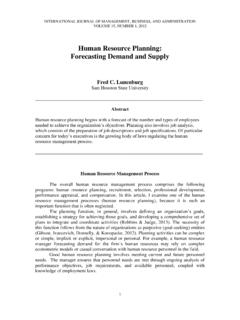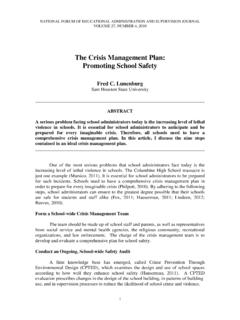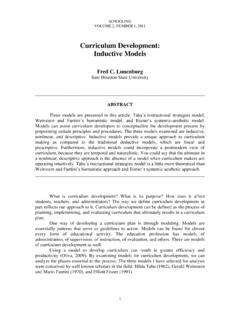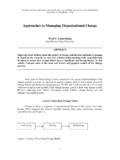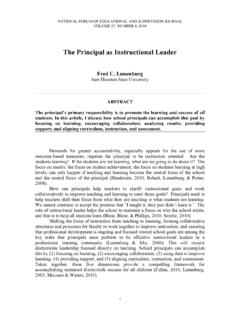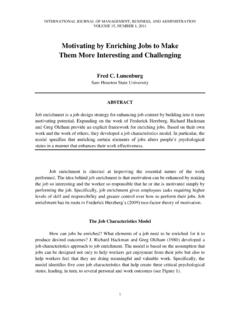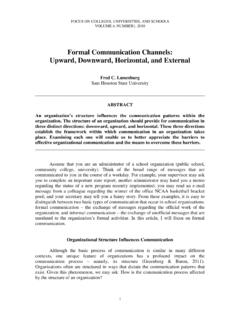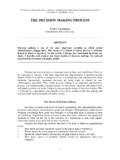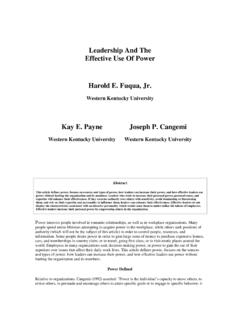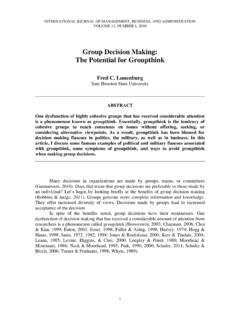Transcription of SCHOOLS AS OPEN SYSTEMS - National Forum …
1 SCHOOLING VOLUME 1, NUMBER 1, 2010 1 SCHOOLS AS open SYSTEMS Fred C. Lunenburg Sam Houston State University _____ ABSTRACT All public SCHOOLS are open SYSTEMS , although the degree of interaction with their environment may vary. open SYSTEMS contain five basic elements: inputs, transformation process, outputs, feedback, and the environment. In this article, I discuss each of these five elements of social SYSTEMS . The open SYSTEMS view of SCHOOLS provides an excellent framework for analyzing the process of education and the role the school administrator plays in that process. _____ SCHOOLS are social SYSTEMS in which two or more persons work together in a coordinated manner to attain common goals (Norlin, 2009).
2 This definition is useful, for it specifies several important features of SCHOOLS : (1) they consist, ultimately, of people; (2) they are goal-directed in nature; (3) they attain their goals through some form of coordinated effort; and (4) they interact with their external environment. The definition, however, does not elaborate on one important feature of SCHOOLS deserving special attention: All SCHOOLS are open SYSTEMS , although the degree of interaction with their environment may vary. According to open - SYSTEMS views, SCHOOLS constantly interact with their environments. In fact, they need to structure themselves to deal with forces in the world around them (Scott, 2008). In contrast, a closed- system theory views SCHOOLS as sufficiently independent to solve most of their problems through their internal forces, without taking into account forces in the external environment.
3 Consider a school closing or realignment of school boundaries, for example. It affects the people in the school and those outside it in both the community it's moving from and the one it's moving to. SYSTEMS theory works on the inside and outside of the organization, as a way of understanding and anticipating the consequences of any decision (Ahrweiler, 2011). A system can be defined as an interrelated set of elements functioning as an operating unit (Senge, 2006). As depicted in Figure 1, an open system consists of five basic elements (Scott, 2008): inputs, a transformation process, outputs, feedback, and the environment. SCHOOLING 2_____ Environment Organization Feedback Environment Figure 1.
4 open system . Inputs SYSTEMS such as SCHOOLS use four kinds of inputs or resources from the environment: human resources, financial resources, physical resources, and information resources. Human resources include administrative and staff talent, labor, and the like. Financial resources are the capital the school / school district uses to finance both ongoing and long-term operations. Physical resources include supplies, materials, facilities, and equipment. Information resources are knowledge, curricula, data, and other kinds of information utilized by the school / school district. Transformation Process The school administrator's job involves combining and coordinating these various resources to attain the school 's goals learning for all.
5 The interaction between students and teachers is part of the transformation or learning process by which students become educated citizens capable of contributing to society. How do school administrators accomplish this? Work of some kind is done in the system to produce output. The system adds a value added to the work in process (Shaw, 2006). This transformation process includes the internal operation of the organization and its system of operational management. Some components of the system of operational management include the technical competence of school administrators and other staff, their plans of operation, and their ability to cope with change. Tasks performed by school administrators within the organization s structure will affect the school / school district s outputs.
6 Outputs It is the principal s job to secure and use inputs to the SCHOOLS , transform them while considering external variables to produce outputs. In social SYSTEMS , outputs are the attainment of goals or objectives of the school district and are represented by the products, results, outcomes, or accomplishments of the system . Although the kinds of outputs will vary with a specific school , they usually include one or more of the Inputs Transformation Process Outputs Inputs Transformation Process Outputs Inputs Transformation Process Outputs FRED C. LUNENBURG _____3 following: growth and achievement levels of students and teachers, student dropout rates, employee performance and turnover, school -community relations, and job satisfaction.
7 Most of these require no elaboration; only the last one requires some explanation. A school must provide "satisfaction" to members of the school community beyond the physiological needs (salary, working conditions, job security) (Herzberg, 2009). SCHOOLS must provide for employees' needs for affiliation, acceptance, esteem, and perhaps even self-actualization if they hope to retain a motivated, committed work force capable of performing at maximum levels (Maslow, 1998). Feedback Feedback is crucial to the success of the school operation. Negative feedback, for example, can be used to correct deficiencies in the transformation process or the inputs or both, which in turn will have an effect on the school 's future outputs. Environment The environment surrounding the school / school district includes the social, political, and economic forces that impinge on the organization.
8 The environment in the open SYSTEMS model takes on added significance today in a climate of policy accountability. The social, political, and economic contexts in which school administrators work are marked by pressures at the local, state, and federal levels. Thus, school administrators today find it necessary to manage and develop internal operations while concurrently monitoring the environment and anticipating and responding to external demands. Since the enactment of the No Child Left Behind (NCLB) Act of 2001(Public Law 107-110), education has been near the top of the National political agenda. The federal law nationalized the discussion concerning the well-being of public schooling in America.
9 At the time the report was released and subsequently, there has been concern with an achievement gap in America (Darling-Hammond, 2010; DuFour, DuFour, Eaker, & Karhanek, 2010; Howard, 2011; Paige, 2011) and our academic competitiveness with other nations, particularly in mathematics and science ( Government Printing Office, 2008). These achievement gaps and academic comparisons have led many people to conclude that the public school system was underperforming. With recognition of an achievement gap and the rise of international educational comparisons, states began to focus their policy on standards, accountability, and the improvement of student academic achievement (Bulach, Lunenburg, & Potter, 2008; Sunderman, 2008). Statewide assessment SYSTEMS were implemented nationwide.
10 Thus was born an era of high-stakes testing complete with rewards and sanctions for low-performing SCHOOLS . The social, political, and economic forces that impinge on the school organization are not all state and National , however. Local school administrators also face a number of challenges that are exclusively local in nature, such as bond referenda, difficult school boards, and teacher unions. These local political issues can at times confound state mandated policies (Lunenburg & Ornstein, 2008). For example, school administrators often face mandated programs that do not meet the changing demographics of their student population. Teachers are often bound by union contracts that conflict with the norms of their particular school or school district.
